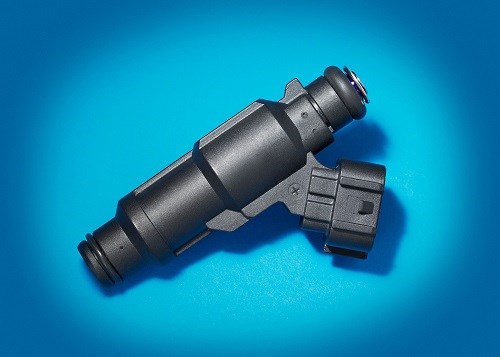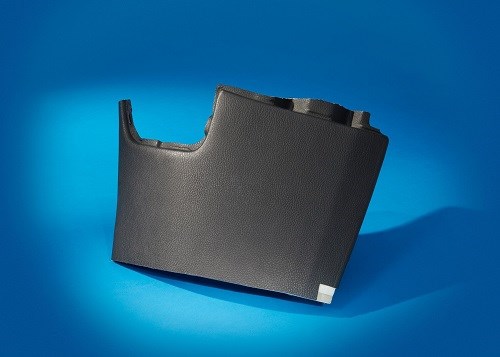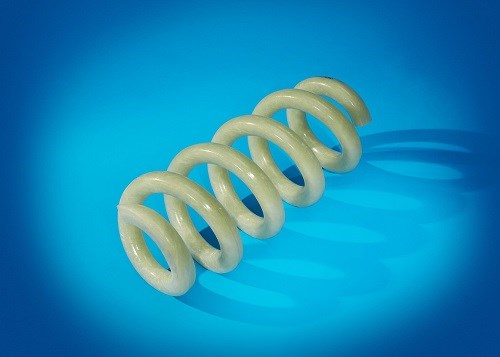SPE Winners in Powertrain, Chassis & Process Assembly
More on top innovations from 2015 SPE Automotive Awards
Take a look at the winners of the SPE Automotive Division 2015 Blue Ribbon Automotive Innovation Awards in the categories of Powertrain, Chassis/Hardware, and Process/Assembly.

Powertrain: Heated-Tip Fuel Injector
The 2015 Honda Fit subcompact and Honda City vehicles sold in Brazil feature the innovative heated-tip port fuel injector that improves cold-start performance in ethanol-fueled vehicles. Its development was a joint effort between Honda Motors, Delphi Automotive (U.S. office in Troy, Mich.) and DuPont Automotive, Wilmington, Del.
The Delphi Multec 3.5 Heated Tip Port Fuel Injector technology addresses an issue that has plagued vehicles that run on 100 percent ethanol (E100): This fuel will not form a combustible vapor at cold temperatures (below 55 F) so engine-starting is not possible with a conventional system. In Brazil, where this fuel is commonly used, most automakers have had to add a second gasoline fuel system for starting at colder temperatures. This team solved this issue with this innovation which features an electrical heater within the injector which is energized by the vehicle controller, rapidly heating the ethanol fuel and dramatically improving vaporization while reducing emissions.
Ink materials (dielectric, conductive, and resistive inks) used in the construction of the heater, selected for their specific thermal and adhesive properties and performance, as well as the thick film ink-printing process on the injector body were key to this development. Moreover, the overmold material more than sealed the deal. DuPont developed a high performance nylon (Zytel HTN54G35EF BKB336 PPA) to withstand heater temperatures without degradation. This unique polymer was designed with low halide ion content with heat stabilization, while being compatible with the unique heater inks.
The material viscosity and injection molding process were optimized to prevent collapse of the thin-wall injector body and distortion of heated tip injector terminals during molding. A laser-etchable colorant was added to the polymer to provide part manufacturing identifications. This device saved $60/vehicle as well as 19.84 lbs to improve fuel economy, along with significantly lowering costs by eliminating a secondary gasoline sub-tank system.

Process/Assembly/Enabling Technologies: IMX Instrument Panel
Hyundai Motor’s 2014 Hyundai i20 supermini, via a two-shot compression-injection molding process, features the soft IMX TPO instrument panel (IP) that eliminates scratches and a hard plastic feel.
Hyandai America Tech Center, Inc., Superior Township, Mich., worked with tier one supplier Hyundai-Mobis and materials supplier Hanwha L&C to bring this IP to fruition. The back-foamed foil Multiflex 3202 TPO is compression-injected with the filled PP substrate which in turn is then integrally injection molded with the TPO passenger-side airbag door. All the work is done in a single tool. To increase the foam’s softness and stability of the integral injection molding, the TRIZ (Theory of Inventive Problem Solving) method and experimental tools were used. The resulting part saves $10/vehicle and reduces mass by 0.66 lbs by the integration of the airbag door.

Chassis/Hardware: Fiberglass/Epoxy Composite Coil Spring
Audi AG’s 2015 Audi A6 Avant wagon features a weight-saving epoxy/fiberglass composite coil spring that is the first of its kind to be used in the suspension system of a series-production vehicle. Audi worked with Italy’s tier one S.ARA Composites, part of the SOGEFI group, and materials supplier Hexion, Inc., Columbus, Ohio to develop this unique part to replace traditional steel coil springs.
Significant work was done by Hexion on the Epikote epoxy chemistry and resin/fiberglass interface to ensure efficient load transfer and long-term mechanical performance. In addition to developing the optimized composite, a patented, modified filament winding process was developed—proven to be a cost-effective production method capable of meeting build volumes. The new coils springs reduced weight by 40% and enabled the suspension system to react more quickly to changing road surface conditions, which improved both vehicle handling and NVH (noise, vibration, harshness).
Related Content
The Fundamentals of Polyethylene – Part 1: The Basics
You would think we’d know all there is to know about a material that was commercialized 80 years ago. Not so for polyethylene. Let’s start by brushing up on the basics.
Read MorePrices of PE, PP, PS, PVC Drop
Generally, a bottoming-out appears to be the projected pricing trajectory.
Read MoreFundamentals of Polyethylene – Part 3: Field Failures
Polyethylene parts can fail when an inappropriate density is selected. Let’s look at some examples and examine what happened and why.
Read MoreDensity & Molecular Weight in Polyethylene
This so-called 'commodity' material is actually quite complex, making selecting the right type a challenge.
Read MoreRead Next
Troubleshooting Screw and Barrel Wear in Extrusion
Extruder screws and barrels will wear over time. If you are seeing a reduction in specific rate and higher discharge temperatures, wear is the likely culprit.
Read MoreAdvanced Recycling: Beyond Pyrolysis
Consumer-product brand owners increasingly see advanced chemical recycling as a necessary complement to mechanical recycling if they are to meet ambitious goals for a circular economy in the next decade. Dozens of technology providers are developing new technologies to overcome the limitations of existing pyrolysis methods and to commercialize various alternative approaches to chemical recycling of plastics.
Read MoreWhy (and What) You Need to Dry
Other than polyolefins, almost every other polymer exhibits some level of polarity and therefore can absorb a certain amount of moisture from the atmosphere. Here’s a look at some of these materials, and what needs to be done to dry them.
Read More


























